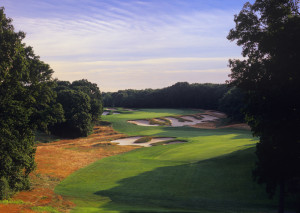Serious golf is about to be played this week at the WGC-Cadillac Championship as the top three golfers in the world will tee it up together for the first time in 2016.
Trump National Doral, aka The Blue Monster will look a bit different this year as Gil Hanse was given the OK by his lordship The Donald to tweak his still fresh redesign. There will be some narrower landing areas for the long hitters as Hanse has moved in some bunkers and squeezed in a few fairways to try and take the obvious advantage of flying the ball over all the trouble.
Hopefully we will be talking about the golf and the golfers and not about his Royal Doucheness Donald Trump all week. If I want Trump I’ll turn on CNN and I won’t be turning on CNN.
Trump calls all his courses great and of course we all know his punchline “Make America Great Again” but I would just be happy to watch some golf and for The Donald to go back to worrying about his golf empire and not his attempt at an American Empire.
But that word great, which he uses far too often is also used to describe our beloved golf courses. We all can’t wait to get on one of the Great Courses as rated by the golf entities. And any course that makes one of those lists automatically gets a boost in play and reputation.
But what makes a course great? It’s a truly subjective and difficult question.
Links Magazine’s Winter issue asks just that on it’s cover article. And it takes some input from some of the world’s most renowned designers and course aficionados.
Thomas Dunne discusses “Shot Values”, a relatively new term today.
These days, the analytical approach is encapsulated by something called “shot values.” A term bandied about at many a 19th hole, it seldom means the same thing from one golfer to the next. Golf Digest’s definition (“How well do the holes pose risks and rewards and equally test length, accuracy, and finesse?”) is probably the one that has most filtered down into the general population of golfers. That magazine’s architecture editor, Ron Whitten, made a couple of points via email that hint at what a rigorous mental exercise thinking about “shot values” can be. “It doesn’t require that each hole provide a variety of risks and rewards,” he notes, “just that the full 18 holes of a golf course do so.” So shot values must be considered both in relation to the individual hole as well as how that hole fits into the collective.
David McLay Kidd in his “My Journey to Understanding” essay talks about how he came back to designing courses that “made golf fun” again.
I created courses that were “Best New” this, “Development of the Year” that. I was ranked “Architect of the Year” for my efforts, and my clients were thrilled.
But in the midst of all this I stopped hearing real golfers say how much fun they were having. And so I re-evaluated. I went back to Bandon Dunes, now with four courses, and asked myself what made these courses great. The answer was still there, as it had been when I created the first course: simplicity.
And golf connoisseur emeritus George Peper in his “Defiantly Indefinable” says that actually defining what makes a great course great is an exercise in futility.
You see, golf course greatness defies definitive description for two reasons. First, it’s largely in the eye of the beholder; there are no objective criteria, no universally held standards. The unique combination of challenge and charm that appeals to you likely won’t work for me. Second, even if you and I could agree—and a critical mass of our golf-playing brethren could join us in the embrace of a definition—we couldn’t trust ourselves to be right. Why? Because history has shown that the definition of a great golf course is ephemeral, constantly evolving.
Beauty and greatness are in the eye of the beholder…especially on a golf course. And I, a true architecture novice would struggle in defining what makes some courses great. Sure, I read the lists and certainly am subject to the renown that a historic course carries. But put a gun to my head and I would probably have a hard time describing what makes a good course without stealing thoughts from others.
But I know this, I like having fun on the course. And I like golf courses that are fun.
The toughest course I ever played is Bethpage Black and while it was a thrill to walk the same course that the pros do and challenge one of A.W. Tillinghast’s best, if I had to play that twice a week I’d probably give up the game.
I favor what Ben Crenshaw said about great courses, “A good golf course makes you want to play so badly that you hardly have time to change your shoes.”
I like what Gil Hanse has to say, “What makes a golf course great in my mind is instant recall/memorability and the desire to get back out there again.”
Tom Fazio takes his description beyond the sand and the turf, “Most golf courses are not blessed with storied histories, dramatic natural settings, unlimited construction budgets, or flawless maintenance. But that doesn’t mean they can’t be great. To me a great course is one I love to play or one that has been important and special to me at some point in my life. We can all think of some “great” courses in our lives that wouldn’t necessarily come near the Top 100 lists. That is one of the great things about golf.”
Fazio is spot on. A great course may give you some wonderful memories but a “not so great” course is just as able.
Those rounds at Bethpage weren’t just memorable because of the golf but because of the company. Thirty six holes at Florida’s top rated World Woods wasn’t just the amazing layout, it was the camaraderie. The weekly rounds at the local muni are the memories that last a long time. And the nine holes with the boys at the beaten up Dogpatch make memories for a lifetime.
Don’t get me wrong, I cherish rounds on those “great” courses and the golf is memorable.
But most of the time it’s the company that makes it unforgettable.
